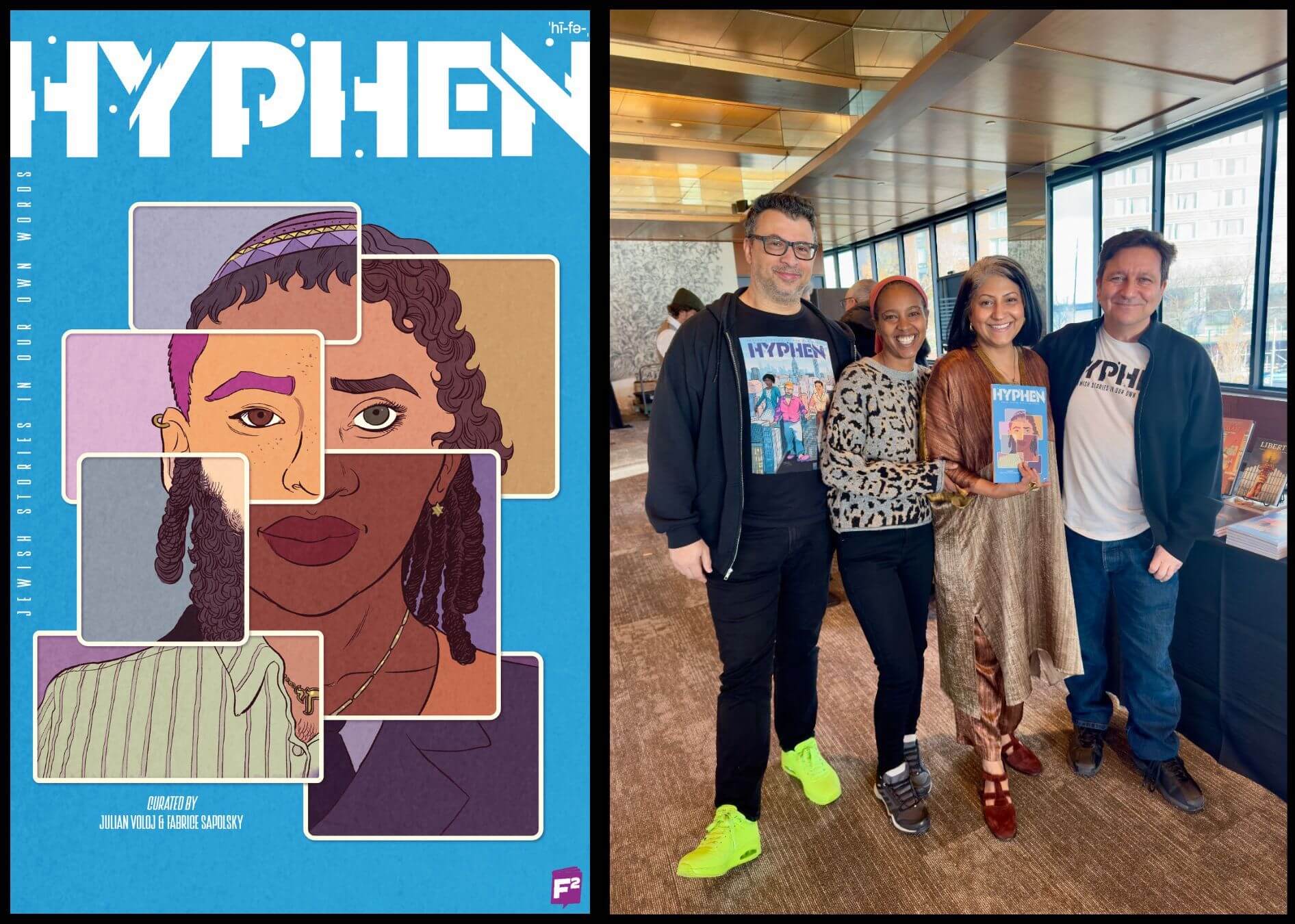With stories from Jews across the globe, this graphic anthology wants to expand how we see Jewishness
‘Hyphen: Jewish Stories In Our Own Word’ features twelve stories of Jews with different ethnic, racial, and gender identities.

From Left to Right: Fabrice Sapolsky, Haftam Yizhak Heathwood, Eddna Samuel, and Julian Voloj. Sapolsky and Voloj came up with the idea for ‘Hyphen,’ which includes stories from Haftam and Eddna’s lives. Courtesy of Julian Voloj
When photographer Julian Voloj heard about the first Jewish Comic Con in Brooklyn, he knew he had to meet its creator, Fabrice Sapolsky. Voloj, who was born in Germany to Colombian parents, had previously authored a number of graphic novels, including Ghetto Brother, the story of former gang leader Benji Melendez, a Puerto-Rican Jew. Voloj and Sapolsky connected at the 2016 convention and realized they shared a vision: a comic that would depict diverse Jewish stories.
Sapolsky, who is French-American with Ashkenazi and Sephardic roots, had been a comic creator for many years, including for Marvel and DC.
“He had this network of illustrators,” Voloj said. “I had the network of ethnically, racially diverse Jews.”
Voloj serves as the executive director for Be’Chol Lashon, an organization dedicated to highlighting Jewish diversity through community events and art. In November 2023, with the organization’s support, Voloj and Sapolsky created a sampler of their imagined anthology Hyphen: Jewish Stories in Our Own Words featuring three stories about Jews who did not fit the archetypal image of what a Jew should be, whether that be because of their racial identity, ethnic identity, or LGBTQ+ identity.
After sharing the Hyphen preview at synagogues and Jewish community centers, Voloj and Sapolsky secured funding to create the official anthology which contains 12 stories — including their own.
Some of the subjects wrote their stories, but others worked with Voloj to figure out what they wanted their section to be.
Haftam’s story of escaping war in Ethiopia starts with an explanation of the holiday of Sigd, which takes place 50 days after the end of Yom Kippur and marks another day of repentance for Ethiopian Jews. Natan’s chapter about battling his unibrow includes a crash course on the Bukharian Jewish language. The section on Eddna, a Jewish woman from Mumbai who eventually immigrates to Israel, provides history on Jews in India.
“You not only get a personal narrative, but also a broader story,” Voloj said.
Although some don’t accept the validity of all the ways Hyphen presents Jewishness, Voloj sees the wide variety of Jewish practice on display in Hyphen as part of what makes Judaism special.
“The terminology for me is always [to] say it’s Jewish communities,” Voloj said. “There’s not something like the Jewish community. So even if you have two Hasids, they might not agree on anything. If you’re a Satmar or if you’re Chabad, I mean, there’s very different philosophies.”
Voloj said that there has also been a lot of excitement and emotional responses to Hyphen.
“I feel like what people can relate to, it’s personal stories. So one story is about a woman that grew up in India, but she’s also like a single mom,” Voloj said. “Her son moves to Israel, and she decided to just follow him. So it’s like basically a story about motherhood,”
The fact that Hyphen is a comic has also helped to broaden its appeal.
“It’s such an American thing and such an intergenerational thing,” Voloj said. “We had the JCC events, there were some people who were over 60. And there the youngest persons were under 10.”
Because they had limited space and wanted each chapter to represent a different identity, a lot of stories didn’t make it into the anthology. Voloj hopes that in the future, they can continue the series.
“At the end of the book, we have photos of the main storytellers. So you can actually see these are all real people,” said Voloj. “And that gives it a nice note like, ‘Oh, yeah, these are like all the different faces of Judaism, and they all look different.’”
“I think that’s a beautiful thing to show. And I feel like it’s a great way to build bridges.”

















